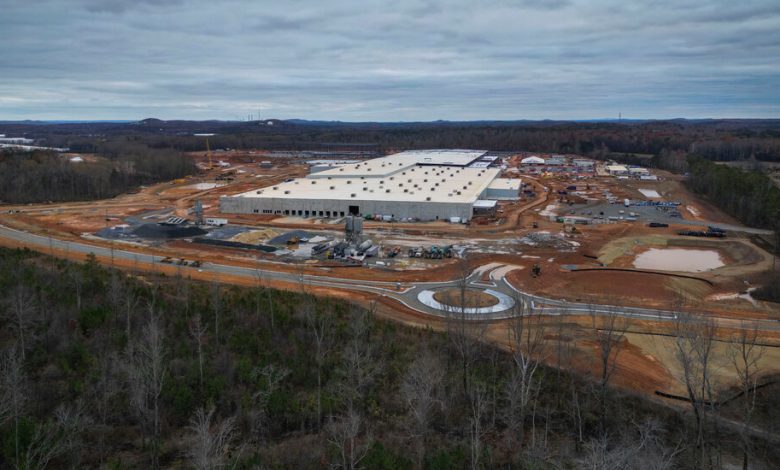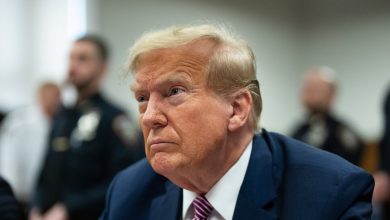Could Biden’s Clean Energy Push Be a Victim of Its Success?

Dalton, Ga., was once known as the carpet capital of the country. Economic diversification meant branching out from wall-to-wall to hardwood flooring. Now, at Qcells, a solar panel company, robots patrol acres of shop floor where delicate solar cells are packaged, laminated and boxed into sophisticated panels — 6,000 a day — in a highly automated production line.
The company built a massive factory in Georgia — one of the most crucial states in the 2024 presidential election — and has another in the works. Both plants will employ thousands of people, underwritten by President Biden’s signature clean energy initiative, the Inflation Reduction Act.
“Just coming in here, you feel like this is the future,” Wayne Lock, 32, a Qcells quality engineer, said as he walked the production line, which has bustled since Mr. Biden signed the law in August 2022. “We’re advancing and keeping up with the world.”
But rather than bragging, Qcells executives are raising an alarm. The Biden clean energy initiative is bringing plants like theirs on line at breakneck speed. And the rate of production — at home and abroad — has created the prospect of a glutted market that threatens to drive down the price of solar panels as the supply outpaces demand.
Mr. Biden’s political advantage in the clean energy economy could turn into a crippling liability, bordering on a nightmare: shutdowns and canceled construction plans rippling across the country, including in key 2024 states like Georgia, Arizona and Colorado.
“We should be very worried,” said Mike Carr, executive director of the Solar Energy Manufacturers for America Coalition, a trade association. “We are very worried.”
Even Biden administration officials described the circumstances when the clean energy law passed last year as “much rosier” than now.
The bankruptcy in 2011 of another solar venture, Solyndra, which cost federal taxpayers hundreds of millions, haunted the Obama administration the last time a Democratic president tried to bolster clean energy to address climate change. Republicans whipped it into a scandal, and even solar industry supporters said it was a black eye — for former President Barack Obama politically and for solar power economically.
Biden administration officials take pains to note that this time around, tax incentives in the Inflation Reduction Act are intended to attract private investors and that the incentives cost the government only when solar panels are sold and installed.
Mr. Biden has a lot of capital resting on the solar boom: jobs with political appeal, clean energy development that could attract climate-conscious young voters souring on the president over other issues and a general sense that the Biden White House is a transformative power, not a stolid caretaker government.
At first glance, Qcells’ operations look like an unmitigated success. In the heart of the House district of Representative Marjorie Taylor Greene, a Republican who has spent more time trying to impeach Mr. Biden than supporting his clean energy program, Qcells, a subsidiary of a South Korean conglomerate, Hanwha, has invested $208 million and more than doubled its production of solar panels.

“Just coming in here, you feel like this is the future,” said Wayne Lock, a Qcells quality engineer.
The 800 workers who built panels in Dalton before Mr. Biden’s legislation have been bolstered by further thousand since the law’s passage. A $2.3 billion plant in Cartersville, triple the size of Dalton’s and going up on 175 acres of Georgia red clay, will begin to come on line in January, making not only the finished panels but also components of the panels — glass ingots, polysilicon wafers and solar cells — now made almost entirely in East Asia.
The Redeemer Plant in Cartersville, already a vast 2.4 million total square feet, will be the largest solar manufacturing operation in the country, and once both plants are fully on line, Qcells will be producing 45,000 solar panels a day in Georgia.
That “wouldn’t have happened without the I.R.A.,” said Marta Stoepker, a Qcells spokeswoman, referring to the Inflation Reduction Act.
The legislation, while subsidizing renewable energy like solar and wind, offers an extra tax credit for developers who install American-made solar panels, with added incentives for the use of American-made components, such as the highly pure silicon that another Qcells affiliate is refining in Washington State and the wafers, cells and panel wrapping that the company will make in Cartersville. Qcells earns a tax credit of $41.30 for every 590-watt panel made in Georgia.
But a dark cloud hangs over the solar industry’s rapid expansion, and it emanates from China. Wood Mackenzie, an independent energy research firm, recently wrote that the $130 billion that China has invested to maintain its control over solar panel components has created enough capacity to meet annual global demand until 2032, with a cost of production that is 65 percent cheaper than it is in the United States.
At one time, solar energy analysts thought the industry could compete with natural gas if a watt of electricity could be generated for $1. The global price has plunged to 14 cents a watt, down 37 percent since January. U.S. prices are at 30 cents, thanks to trade barriers, but that is still remarkably low.
Not everyone finds this problematic. Companies like Maxeon Solar Technologies, in Colorado and New Mexico, and Suniva in Norcross, Ga., which are focused on the final assembly and deployment of solar panels, are happy with buying cheaper components from Asia and don’t want a headlong rush toward protectionism. JA Solar, a Chinese company, is building a solar plant in Phoenix, creating more than 600 jobs without raising any alarms about Beijing.
Others in the solar industry want help, fast. They have called for tougher enforcement of trade penalties on Southeast Asian factories that are nominally free of Chinese influence but in fact are just adding finishing touches to Chinese-made components, and tax preferences for U.S.-made components down to the very fine silicon that is formed into glass in solar cells.
The United States imported a record number of foreign-made solar panels in July, August and September, S&P Global Market Intelligence said this month, up 55 percent from a year earlier and 30 percent from the three months before, the previous record.
Calls for protection are getting bipartisan support in Congress. Senators Sherrod Brown, Democrat of Ohio, and Todd Young, Republican of Indiana, have new legislation to combat China’s efforts to circumvent trade enforcement by going around tariffs. Senator Jon Ossoff, Democrat of Georgia and the author of the solar provisions in the Inflation Reduction Act, is expressing his concerns as well.
“The United States must prevent this flood of cheap Chinese imports from once again killing domestic manufacturing,” Senator Ossoff said. “This is a national security issue.”
Officially, the Solar Energy Industries Association has a rosier view. By 2030, the trade association says, Mr. Biden’s legislation will have expanded the solar manufacturing work force to 115,000 Americans, and to more than 507,000 if transportation, installation and other industries are included. Solar energy production and storage should represent 30 percent of total domestic electricity generation by 2030.
But Wood Mackenzie sees trouble. “Oversupply and intense competition will characterize the solar supply chain going forward, and is already driving cancellations of some expansion plans,” the firm wrote this month.
And while residential consumer demand has been strong, the biggest consumer — solar farm developers connected to electric utilities — have hit bottlenecks with transmission lines, transformers and land acquisition at a time of rising interest rates.
Whether solar panels and their components are made in the United States or China, their deployment in the nation’s energy grid is fulfilling a central promise of Mr. Biden’s: to address climate change. Renewable sources of energy like wind and solar now make up 80 percent of new electricity generation capacity. Greenhouse gas emissions are falling, even as the American economy and population grow.
The Treasury Department believes that, for now, it has found the proper regulatory balance between fostering American-made solar products and facilitating the deployment of cheap, clean solar energy.
But Mr. Biden’s re-election may depend more on rallying voters around economic progress than persuading them to care about his climate successes. Administration officials said more data was needed over the next few months to determine whether Inflation Reduction Act-driven overcapacity needs a policy answer, but they did not foreclose on new trade protections soon.
Mr. Carr, of the solar energy association, says Republicans are eager to repeal the tax incentives in the Inflation Reduction Act, which would strangle the industry. If they can successfully argue that those incentives are mainly helping China, the repeal effort could succeed, hurting domestic manufacturers and efforts to combat climate change.
“It’s a real crisis point, and I think a real political problem.”



